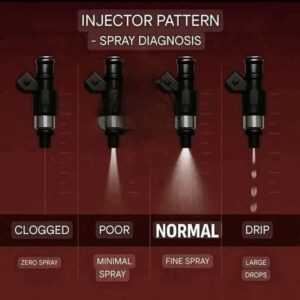
Common Symptoms of a Faulty Crankshaft:
A malfunctioning crankshaft can significantly affect engine performance. The most common symptoms include:
- Illuminated Check Engine Light:
A defective crankshaft sensor may activate the check engine light, indicating that the engine control module has detected issues with the crankshaft’s position or speed readings. - Decreased Fuel Efficiency:
A faulty crankshaft can cause inefficient fuel combustion, forcing the engine to work harder and consume more fuel, leading to reduced gas mileage. - Engine Stalling:
The crankshaft sensor provides crucial timing information. If it malfunctions, the engine might lose synchronization, causing unexpected stalling during operation. - Excessive Engine Vibrations:
A damaged or unbalanced crankshaft disrupts the engine’s smooth rotation, leading to noticeable vibrations, particularly when idling or at low RPMs. - Engine Misfires:
Incorrect data from the crankshaft sensor can lead to improper ignition timing or fuel injection, resulting in misfires and diminished performance. - Sluggish Acceleration:
When the crankshaft sensor fails to transmit accurate signals, the engine may struggle to respond to acceleration demands, resulting in poor performance. - Low Oil Pressure:
A malfunctioning crankshaft can disrupt the engine’s oil flow, reducing oil pressure and potentially leading to severe engine damage if unresolved.


More Stories
Diesel vs. Petrol: Which Fuel is Right for You? 🚗⚙️
Choosing between diesel and petrol depends on how you drive. Here's a quick comparison: 🔧 Diesel: ✅ More energy-dense ✅...
understanding your vehicle’s warning and indicator lights:
📖The image displays common car dashboard symbols and their meanings, providing a visual guide to understanding your vehicle's warning and...
Causes and Signs of Damage to the Reverse-Axle Clutch
Graphics The clutch is a critical component in vehicles, consisting of two parts: inner and outer clutch. It transmits power...
Understanding Car Fuses and Fuse Box Symbols
🚗 Graphics 🔧 Ever wondered about the role of fuses in your car? These small yet essential components play a...
Features of the MacPherson Strut Suspension System
Particularly for smaller automobiles, the MacPherson strut is one of the most often used vehicle suspension systems among manufacturers. Drivers...
The Pressure Plate: An Essential Part of the Clutch System in Your Car
The Pressure Plate The pressure plate is one of the most crucial parts of the clutch system in your car,...


